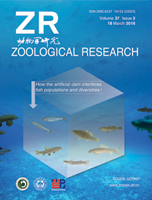
|
Zoological Research
Kunming Institute of Zoology, Chinese Academy of Sciences
ISSN: 2095-8137
Vol. 41, No. 1, 2020, pp. 3-19
|
 Bioline Code: zr20002
Bioline Code: zr20002
Full paper language: English
Document type: Research Article
Document available free of charge
|
|
|
Zoological Research, Vol. 41, No. 1, 2020, pp. 3-19
| en |
Neuroprotectants attenuate hypobaric hypoxia-induced brain injuries in cynomolgus monkeys
Zhang, Pei; Chen, Jie-Si; Li, Qi-Ye; Sheng, Long-Xiang; Gao, Yi-Xing; Lu, Bing-Zheng; Zhu, Wen-Bo; Zhan, Xiao-Yu; Li, Yuan; Yuan, Zhi-Bing; Xu, Gang; Qiu, Bi-Tao; Yan, Min; Guo, Chun-Xue; Wang, You-Qiong; Huang, Yi-Jun; Zhang, Jing-Xia; Liu, Fu-Yu; Tang, Zhong-Wei; Lin, Sui-Zhen; Cooper, David N.; Yang, Huan-Ming; Wang, Jian; Gao, Yu-Qi; Yin, Wei; Zhang, Guo-Jie & Yan, Guang-Mei
Abstract
Hypobaric hypoxia (HH) exposure can cause serious
brain injury as well as life-threatening cerebral
edema in severe cases. Previous studies on the
mechanisms of HH-induced brain injury have been
conducted primarily using non-primate animal
models that are genetically distant to humans, thus
hindering the development of disease treatment.
Here, we report that cynomolgus monkeys ( Macaca fascicularis

) exposed to acute HH developed humanlike
HH syndrome involving severe brain injury and
abnormal behavior. Transcriptome profiling of white
blood cells and brain tissue from monkeys exposed
to increasing altitude revealed the central role of the
HIF-1 and other novel signaling pathways, such as
the vitamin D receptor (VDR) signaling pathway, in
co-regulating HH-induced inflammation processes.
We also observed profound transcriptomic
alterations in brains after exposure to acute HH,
including the activation of angiogenesis and
impairment of aerobic respiration and protein folding
processes, which likely underlie the pathological
effects of HH-induced brain injury. Administration of
progesterone (PROG) and steroid neuroprotectant
5α-androst-3β,5,6β-triol (TRIOL) significantly
attenuated brain injuries and rescued the
transcriptomic changes induced by acute HH.
Functional investigation of the affected genes
suggested that these two neuroprotectants protect
the brain by targeting different pathways, with PROG
enhancing erythropoiesis and TRIOL suppressing
glutamate-induced excitotoxicity. Thus, this study
advances our understanding of the pathology
induced by acute HH and provides potential
compounds for the development of neuroprotectant
drugs for therapeutic treatment.
Keywords
Acute hypobaric hypoxia; Cynomolgus monkeys; Brain injury; Neuroprotectant; Gene regulatory networks
|
| |
© Copyright 2020 - Editorial Office of Zoological Research, Kunming Institute of Zoology, Chinese Academy of Sciences
Alternative site location: http://www.zoores.ac.cn/
|
|
